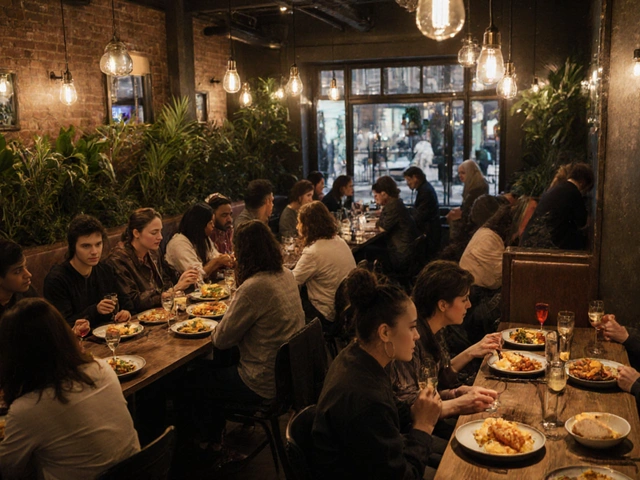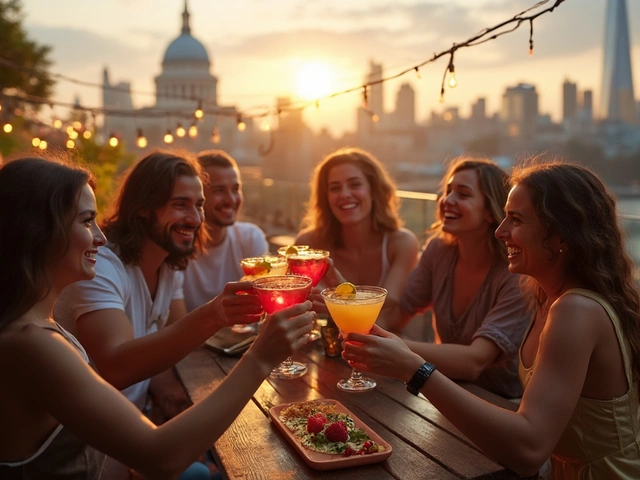
You’ve walked past the sizzling woks in Chinatown, smelled the fragrant spices drifting from a tiny curry house in Brick Lane, and maybe even tried that strange-looking street food stall near Brixton Market. But have you really tasted London? Not the pub grub, not the afternoon tea, not even the famous fish and chips. I mean the real London-the one that smells like cumin, tastes like fermented black bean, and sounds like ten different languages being spoken at once. This city isn’t just a capital. It’s a global kitchen.
London’s Ethnic Restaurants Aren’t Just a Trend-They’re the Heartbeat
Let’s get one thing straight: London’s ethnic food scene isn’t some trendy add-on. It’s been here for decades, built by immigrants who brought their kitchens with them. In the 1970s, Bangladeshi families opened curry houses in East London because they missed home. In the 1990s, Nigerian traders started selling jollof rice in Peckham. In the 2010s, Syrian refugees turned their home recipes into pop-ups in Hackney. Today, over 300 different national cuisines are served in London. That’s more than any other city in Europe.
And it’s not just about quantity. It’s about authenticity. You won’t find a single “British Indian” curry here that’s been watered down for tourists. In Wembley, you’ll eat lamb karahi made the way it is in Lahore-with charred onions, fresh coriander, and enough chili to make your eyes water. In Stockwell, you’ll sip suya-spiced beef skewers grilled over charcoal, just like they do in Lagos. These aren’t adaptations. These are traditions.
Where to Start: The Top Ethnic Food Districts
If you’re new to London’s ethnic food scene, don’t just wander. Head straight to the neighborhoods where the food is cooked by the people who grew up eating it.
- Brick Lane (East London) - The undisputed curry capital. But don’t just go for the tourist traps. Try Shah Jalal for a rich, slow-cooked beef korma, or Ali’s for a butter chicken that’s so tender, it falls off the bone. The real secret? Go after 8 PM. That’s when the locals come.
- Chinatown (Soho) - Yes, it’s crowded. But it’s also the best place in the UK for authentic Cantonese dim sum. Head to China Tang for har gow that’s so delicate, you can see the shrimp through the wrapper. Or try Yum Cha for a modern twist-crab dumplings with truffle oil, served in bamboo steamers.
- Wembley (North West London) - This is where you’ll find the most Pakistani and Afghan food outside of the subcontinent. Al Ameen serves nihari, a 12-hour stewed beef shank dish that’s so thick, it clings to the spoon. Don’t skip the naan-baked fresh in a tandoor right in front of you.
- Peckham (South London) - The African food hub. Chop & Change serves Nigerian jollof rice with fried plantains and goat meat so tender, it melts. Yemaya offers Ghanaian banku with pepper sauce that’ll make you sweat, but you’ll keep eating anyway.
- Harlesden (North West London) - A hidden gem for Caribbean food. Queen’s Kitchen makes jerk chicken with a spice rub so complex, it’s been passed down for three generations. The secret? Allspice, scotch bonnet, and a splash of rum in the marinade.
What You’ll Find Beyond the Big Names
London doesn’t stop at Indian, Chinese, and Nigerian. Dig a little deeper, and you’ll find dishes you didn’t even know existed.
Ever tried khao soi? That’s a Northern Thai coconut curry noodle soup with crispy fried noodles on top. You’ll find it at Chinawala in Kentish Town. What about qatayef? A sweet, stuffed Arabic pancake drizzled with syrup and served warm-best eaten at Al Wadi in Walthamstow. Then there’s chakchouka, a North African tomato and pepper stew with eggs poached right in it. La Maison Tunisienne in Camden does it better than any place in Tunis.
And then there’s the food trucks. In Peckham, a Somali-owned truck called Sahra’s Kitchen serves sambusa filled with spiced lentils and beef. In Brixton, a Guyanese van sells pepperpot stew-cooked for 10 hours with cassareep, a bitter extract from cassava. You won’t find this on any guidebook. You’ll only find it by asking locals.
How to Eat Like a Local (Not a Tourist)
Here’s the truth: if you walk into a restaurant with a menu in English only, you’re probably not getting the real deal. The best ethnic spots often have no menu at all-or just a handwritten board in the native language.
Here’s how to navigate:
- Look for crowds of people who look like they’re from the region. If you see a group of Bangladeshi families eating at 7 PM on a Tuesday, that’s your sign.
- Ask what’s fresh today. Not “what’s popular.” “What’s fresh?” That’s how you get the chef’s special.
- Don’t be afraid to point. If you see someone eating something you don’t recognize, point and say, “What’s that?” Most chefs will smile, bring you a taste, and explain it like you’re family.
- Go during lunch. Many ethnic restaurants offer bigger portions at lower prices midday. You’ll get more food, and the kitchen will be less rushed.

What to Expect on Your Plate
London’s ethnic food isn’t just about flavor-it’s about texture, temperature, and timing.
Indian food? It’s served in stages: first the bread, then the curry, then the raita to cool your mouth. Ethiopian food? You eat with your hands, using injera bread to scoop up stews-no forks allowed. Korean food? You get a dozen side dishes (banchan) before the main course even arrives. And in Lebanese restaurants, the mezze platter isn’t an appetizer-it’s the whole meal.
And portion sizes? Don’t expect small plates. In most ethnic spots, one dish feeds two people easily. That’s why sharing is part of the culture. Bring friends. Order five things. Let everyone try a bit of everything.
Pricing: You Don’t Need to Spend Big
Here’s the best part: you can eat like a king in London without spending a fortune. In Brick Lane, you can get a full chicken curry with rice and naan for £12. In Peckham, a plate of jollof rice with fried plantains and grilled chicken is £10. In Harlesden, a jerk chicken plate with rice and peas costs £9.50.
Compare that to a £25 pasta dish in a Soho tourist trap. Ethnic restaurants don’t charge for ambiance. They charge for flavor. And that flavor? It’s worth every penny.
What to Avoid
Not all places are created equal. Here’s what to skip:
- Restaurants with English-only menus and plastic flowers on the tables. That’s usually a sign they’re targeting tourists, not locals.
- Places that serve “curry house” food with “mild,” “medium,” and “hot.” That’s not how it’s done. Real curries have layers of spice, not a dial.
- Anything labeled “British Asian” or “Fusion.” That’s code for “we changed the recipe to suit British tastes.”
If you’re unsure, Google the restaurant name + “review” + the country of origin. “Best Pakistani restaurant London” or “real Nigerian food near me.” Real reviews from people who grew up eating it will tell you everything.
Comparison: Ethnic Food vs. “International” Chains
| Feature | Real Ethnic Restaurant | Chain “International” Restaurant |
|---|---|---|
| Ingredients | Imported spices, fresh herbs, traditional cuts of meat | Pre-packaged sauces, frozen vegetables, standardized portions |
| Flavor Profile | Complex, layered, spicy, sour, sweet-balanced by tradition | Simplified, bland, “safe,” designed for mass appeal |
| Portion Size | Generous, meant for sharing | Small, often overpriced |
| Authenticity | Cooked by people from the culture | Staff trained in corporate manuals |
| Price (per person) | £8-£15 | £20-£35 |
There’s no contest. One gives you a memory. The other gives you a meal.
Frequently Asked Questions
What’s the best time to visit London’s ethnic food neighborhoods?
Weekends are busy, but weekdays-especially Tuesday to Thursday-are when the locals eat. You’ll get better service, fresher food, and shorter waits. Many restaurants open at 11 AM and stay open until midnight, so you’ve got flexibility.
Are ethnic restaurants in London safe and hygienic?
Yes. All restaurants in London are inspected by the local council and must display a food hygiene rating. Look for the green sticker-“5” is excellent. Most ethnic spots have ratings of 5, especially the ones with long lines. The same rules apply to them as to any other restaurant.
Can I find vegetarian or vegan ethnic food in London?
Absolutely. Indian, Ethiopian, Lebanese, and Thai restaurants have some of the best vegetarian options in the city. Try chana masala, lentil stew (misir wot), stuffed grape leaves, or pad see ew with tofu. Many places even have separate vegan menus.
Do I need to make a reservation?
For smaller places? Usually not. Walk-ins are welcome. But for popular spots like Yum Cha or Shah Jalal, especially on weekends, booking 24 hours ahead saves you hours of waiting. Use Google or WhatsApp-the owner often answers faster than a phone line.
What’s the one dish I shouldn’t leave London without trying?
Go to Chinawala in Kentish Town and order the khao soi. It’s creamy, spicy, crunchy, and comforting all at once. Or head to Queen’s Kitchen in Harlesden for jerk chicken with plantains. Either way, you’ll taste the soul of London-not the version they show on postcards.
Ready to Eat Your Way Through London?
You don’t need a passport to taste the world. Just a hungry stomach and an open mind. Pick one neighborhood this weekend. Try one new dish. Talk to the person behind the counter. Ask what their grandmother used to make. You might just find your new favorite meal-and a piece of London you never knew existed.
Comments (7)
- Kumar Manickam
- November 4, 2025 AT 09:26 AM
I never realized how much of London’s soul is in its food until I read this. I grew up in Delhi, but eating that lamb karahi in Wembley felt like my aunt’s kitchen back home. The chili, the charred onions, the way the meat just melts-it’s not just food, it’s memory on a plate.
And the fact that these places are still run by families who’ve been here for decades? That’s the real magic. No corporate branding, no gimmicks. Just generations of love cooked into every dish.
Also, the tip about going after 8 PM in Brick Lane? Lifesaver. I went at 6 and it was dead. Went back at 9 and the whole place was humming. Locals know.
- adam denature
- November 4, 2025 AT 18:35 PM
Man i just dont get why people make such a big deal about this. Its just food. You eat it you digest it you move on. Why do you gotta turn every curry house into some spiritual experience? Its not a temple its a restaurant. Stop overthinking it.
Also why do you keep saying authentic like its some holy grail. Everything changes. Even your grandma’s recipe changed when she moved cities. Get over it.
- Honey Syal
- November 5, 2025 AT 19:45 PM
Adam, your comment is like a microwave meal-quick, bland, and missing every flavor that makes the original worth eating.
And honestly? Calling a 12-hour nihari stew ‘just food’ is like calling a symphony ‘just noise.’ These dishes carry history, migration, survival, and pride. The fact that you can’t see that says more about you than it does about the food.
Also, I’m Nigerian and I’ve eaten jollof in Lagos, Lagos, and Peckham. The Peckham version? It’s better. Not because it’s ‘authentic’-but because it’s adapted. And that’s beautiful. You don’t have to be from somewhere to honor it.
- Gail Montefalco
- November 6, 2025 AT 17:34 PM
Okay, but… WHY is everyone acting like this is some revolutionary revelation? I mean, come on. London has had ethnic food for 50+ years. This isn’t news. It’s just… fact. And you’re writing a whole essay like you discovered fire.
Also, ‘no plastic flowers’? Really? That’s your litmus test? What about the guy who runs the Thai place with the plastic flamingo? He makes the best pad kra pao in North London. So what? You’re gonna ignore him because his table has a garden gnome?
And ‘British Asian’ is code for ‘we changed it’? Who decided that? Did you interview every chef? No. You just assumed. Classic.
- Hallesha Williams
- November 7, 2025 AT 22:28 PM
yo i read this whole thing and like… the spelling is all over the place. ‘suya-spiced’? should be ‘suya spiced’. ‘chakchouka’? its ‘chakchouka’? wait no its ‘shakshuka’ you got it wrong. and ‘cassareep’? its spelled with two s’s. seriously? you write a 2000 word essay on african food and you cant spell the one ingredient that defines it?
also ‘real ethnic’? what does that even mean? you sound like a food snob with a thesaurus and no life experience. i grew up in lagos and i’ve eaten jollof from street vendors and five star hotels. none of them had ‘authenticity’ labels. they just cooked. you overthink everything.
- akarsh chauhan
- November 9, 2025 AT 10:13 AM
It is regrettable that the author has chosen to elevate culinary traditions to the status of cultural sanctity without acknowledging the economic realities that underpin these establishments. The notion that ‘authenticity’ is synonymous with immigrant-run venues is a romantic fallacy. Many of these businesses operate under precarious conditions, often with minimal regulatory oversight, and their success is not a testament to cultural purity but to economic necessity.
Furthermore, the suggestion that tourists should ‘point and ask’ is patronizing. It reduces cultural exchange to a performative spectacle. One ought to approach such spaces with humility, not as a tourist seeking novelty, but as a student of human practice.
Lastly, the pricing comparison is misleading. The £12 curry does not account for labor, import costs, or the hidden subsidies that allow these businesses to remain viable. To glorify them as ‘cheap’ is to ignore the systemic exploitation that often sustains them.
- Rupesh Deore
- November 9, 2025 AT 23:31 PM
Who cares about the food. You think people come here for the spices? No. They come because they’re bored. They want to post pictures on Instagram. ‘Oh look I ate Nigerian jollof in Peckham’ like its some exotic adventure. Its just rice and meat. Same as back home.
And stop pretending these places are sacred. Most of them are dirty. I’ve seen the grease on the counters. The same guy who makes the curry also cleans the toilet. You think that’s ‘authentic’? Its just poor. And you’re romanticizing poverty.
Also why do you keep saying ‘ask the chef’ like they’re some wise elder. Most of them just want you to shut up and pay. They don’t want to talk. They want to cook. End of story.




